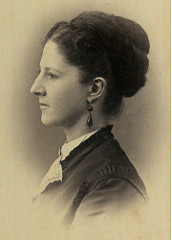Eliza Woolsey Howland to Joseph Howland at Albany.
Sunday (between churches), May 26.
I am going over to the Dutch Church at the Corners more, I confess, to hear the news from Washington than for the sermon’s sake. The rumor by telegraph this morning was that Washington was on fire. I am restless and anxious. There must be important movements on one side or the other before long, now that we have advanced beyond the Potomac.
In yesterday’s papers the great camp preparing on Staten Island is described—10,000 acres on the southeast slope of the island, with room for the tents and evolutions of an army of 60,000 men. Is it likely that you will be ordered there?
Mr. Masters told me this morning to tell you you were not forgotten in the village, for the boys have organized a company and are drilling under the name of the “Howland Guard.” Mother thinks it should be called Mrs. Howland’s Guard. . . . .
May 27. This morning I deposited Mother with the papers at the old chestnut tree seat and helped Thomson and Mechie get a good line for the turf on the carriage road. It is not right yet, but shall be made so. Thomson says: “We’ll na gie it up, ma’am, till you say it’s right.” The sodding round the door and kitchen end[1] is a great improvement and gives quite a finished look. We all took a turn in the wagon after dinner, stopping for me to get some cut-out work from the Women’s Army Association, which is fairly under way now, with Mrs. David Davis as President, Mrs. James Kent Secretary and Miss Rankin Treasurer. Five or six dozen shirts were given out today. . . . I have a note this morning from L. H. H. asking me to make them a visit at Newport and saying Mr. H. would come on for me and bring me back. It is very kind, but I shall stand by my post here this summer. . . .
Mr. Masters told us an anecdote of old R_______ who was in a tavern barroom the other day with a party of rough fellows discussing the war, when one of them declared that “any man who would refuse to go now that Mr. Howland had gone ought to be drummed out of the community.”
[1] Where the rhododendrons are now twelve to fifteen feet high.
